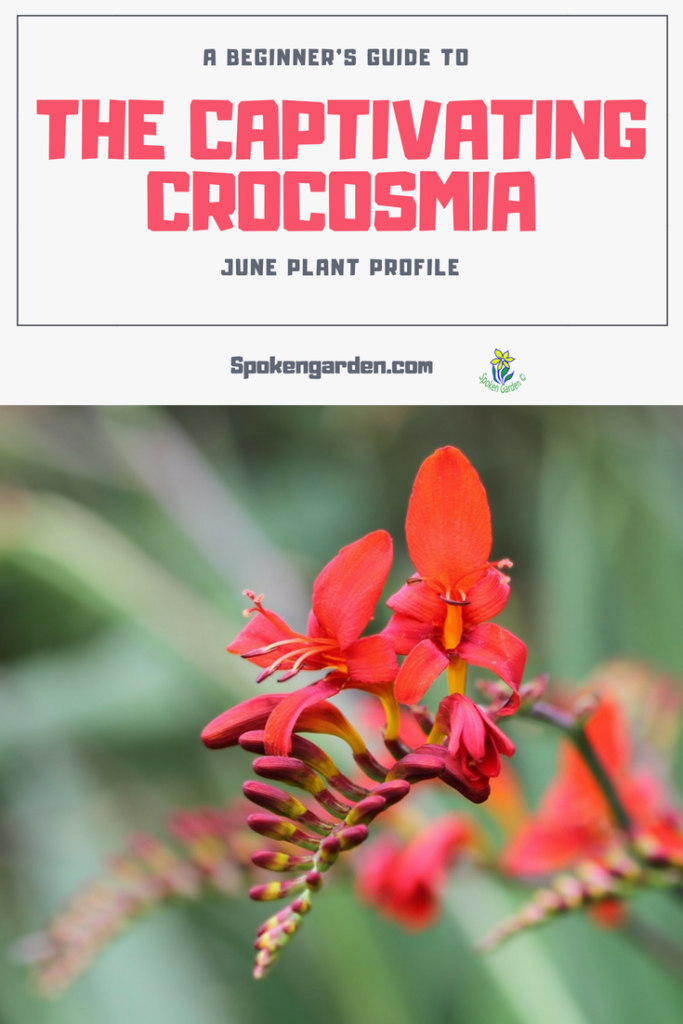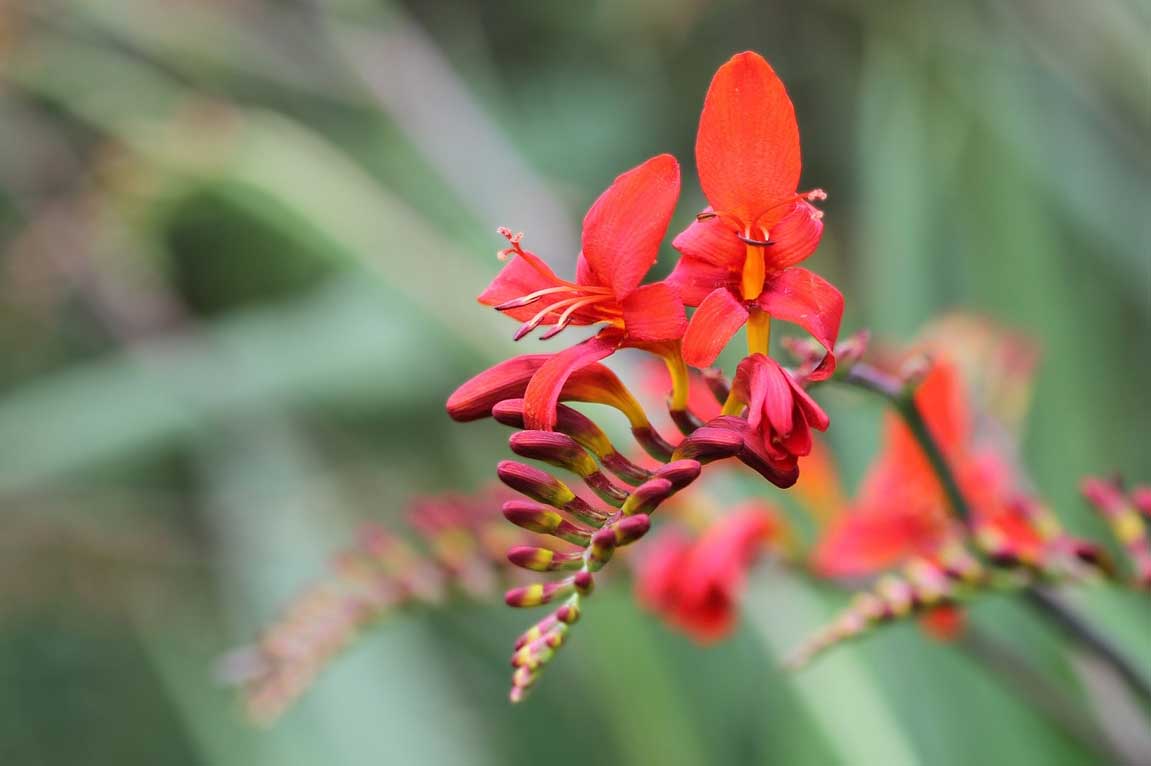Perfect for borders and edges, learn all about the beautiful, showy crocosmia plant in this gardener’s guide.
Crocosmia, a summer-blooming bulb, has the potential to be a true star in your garden beds. From the color of its cultivars to its awesome blooming pattern, this plant has the potential to be a vibrant star in your garden for so many reasons!
Get ready to learn all about crocosmia ‘Lucifer’ plant care, fun facts, and more.
Quick Plant Care Facts
| Sun Exposure | Full sun with some shade in the hottest climates. |
| Water Needs | Regular or moderate during growth and bloom times. |
| Soil Needs | Well-drained, enriched soil. |
| Cold-Hardiness Zones | USDA hardiness zones 6 to 9. |
| Bloom Time | Beginning to mid-Summer or Spring in really hot climates. |
| Flower Colors | Orange, Red, or Yellow, or a mix. |
| Mature Height/Width | Leaves grow almost straight up and are 2.5 feet long with flowers on same leaf-stems reaching a total of 3-4 feet tall. |
| Plant Spacing | Plant corms/plants 2-inches deep and 3-inches apart. |
If you are looking for Summer Flowering Bulbs to add to your garden, look no further than our ebook
21 Spring-Planted Bulbs For Fantastic Summer Color!
It’s has 60+ pages of summer flowering bulb inspiration and you can get to know the different plant care needs of these 21 gorgeous spring-
planted, summer-flowering bulbs.
Whether you are already familiar with bulbs or are just learning about them, this guide explains what bulbs are, defines the 5 different types of bulbs, the correct planting orientation for each of the 5, and much more.
You also get to know each of these 21 spring-planted, summer-flowering bulbs intimately for their care needs like where they will grow, when they flower, different flower colors they are available in, and which online-retailers you can buy your very own to then add to your garden.
Grab your copy now and start planning your spring and summer flower garden TODAY!
Check out our YouTube video below to get started and then read on below to learn even more.
By the way, do you want to plant your bulbs right the first time? Read our eBook, “How to Plant Your Garden Bulbs”: eBook or Paperback.
Jump ahead to the section you want:
Crocosmia: Why We’re Featuring This Plant

Crocosmia is a beautiful, summer bloomer that you should add to your garden for many reasons! Our Crocosmia plant profile will explain more!
You could say this star in the garden “captivated” our attention long ago with its uniqueness and beauty. T
First, the design. Imagine groups of orange, red, or pink trumpet-shaped flowers. These flowers are clustered at the end of tall stems which are surrounded by upright, sword-shaped leaves protruding out of the ground. Wow! This alone can give your garden a whole new tropical and unique look. Your neighbors will be asking you where you bought these amazing plants and sneak looks at your yard when you’re not looking!
Second, did you know that the crocosmia will attract hummingbirds and all kinds of other pollinators? Pollinators are not able to resist this plant due to its shape and variety of colors. Read on to learn what else you can do to attract pollinators to your garden.
Finally, with its climatic growing range, the crocosmia is a perfect plant for your garden because it can thrive just about anywhere, in almost any zone (with a few exceptions, of course).
Another reason we choose crocosmia is due to its July bloom time in our zone 8b. The vibrant, spiky red blooms are equally welcomed by both us and the pollinators.
This plant profile below is meant for beginner gardeners but can be used by anyone who wants to learn more about this captivating plant.
Crocosmia Flowers: Brief History
The crocosmia, part of the Iris family, originates from the tropical areas of Southern Africa. Over time, the plants have been bred and propagated throughout the world.
The name comes from the Greek words of Krokos (Saffron) and osme (odor) referring to the smell of dried Saffron leaves.
In 1879, a Frenchman was able to cross different species together thus initiating the variety of crocosmia cultivars we have in existence. Today, this beautiful plant has over 11 species with numerous varieties and cultivars.
Did you know that this plant is actually considered a weed in parts of England, Australia, New Zealand, South Africa, and parts of Hawaii? Due to its vigorous breeding over the last couple hundred years, crocosmia adapted so well it became a nuisance.
This speaks to its overall adaptability.
These plants can easily reproduce to fill in open spaces in your garden. Good thing they are easy to dig up and place in other parts of your garden by transplanting their corm (a type of bulb) root-system.
By the way, if you haven’t encountered a “corm”- a type of bulb plant – before, think of a tulip or daffodil bulb and then squish them so they are more flat than tall and you have a corm.
Crocosmia thrives so well it is perfect for beginner gardeners. Also, it makes a great addition to containers on patios or decks.
Crocosmia Lucifer
One of the most popular varieties of crocosmia is ‘Lucifer.’ As ominous as the name sounds, ‘Lucifer’ is a beautiful, bright red cultivar that has been bred for long-lasting bloom times, in addition to other traits.
Growing this hardy cultivar in your garden is easy as its needs are few. Once the bulbs (actually, corms) are planted in the fall, ‘Lucifer’ needs well-draining soil and full sun in order to thrive.
As with other cultivars of crocosmia, these perennials are a paradise for pollinators, especially hummingbirds. They cannot resist the shape, size, or color of the flowers.
See the “crocosmia bulbs for sale” section below for our recommended bulbs.
Crocosmia Bulbs For Sale
Also, checkout these helpful articles for your garden:
- How to Attract Pollinators to Your Garden Like a Boss!
- Top 5 Best Pollinators You Should Attract to Your Garden Right Now!
- Bonus Ep 3: How to Rent Mason Bees to Support Your Spring Garden
Crocosmia Plant Conclusion

Our Crocosmia plant profile highlights why pollinators love it!
Crocosmia is captivating, cosmic, crafty, and cool.
Once you have encountered this beautiful plant, you will be hooked. Its ubiquitous uses in your garden can bring depth and texture, while also providing respite to passing pollinators.
Your “garden eye” will forever look for this plants’ form to complement the surrounding world.
For more information on different species, go to the Pacific Bulb Society’s website and geek out on different species for your garden! You could find the perfect crocosmia to compliment your garden.
For information about updating your yard for the spring and summer season, check out our podcast page. Also, If you’re interested in learning about more plants, check out some of our other monthly plant profiles below:
- The Fantastic Fuchsia
- The Curious Calla Lily: April Plant Profile
- A Rose By Any Other Name: February Plant Profile
- The Divine Daffodil: March Plant Profile
See you in the garden!
~ Sean and Allison
P.S. Follow us on Pinterest, Twitter, Facebook, and Instagram so you don’t miss a thing!
Crocosmia References:
- South Africa Biodiversity Institute – Crocosmia aurea
- Hort.net – A brief history of Crocosmia
- Pacific Bulb Society – Crocosmia



